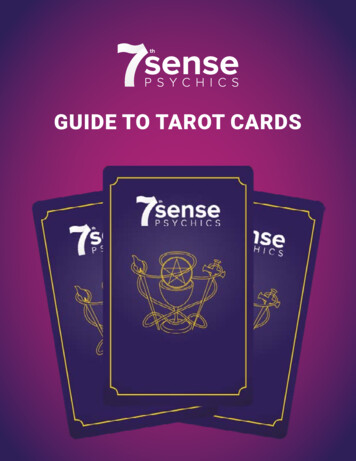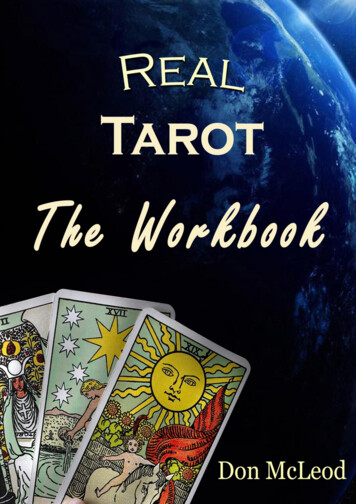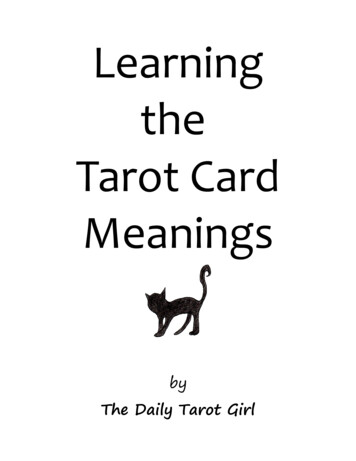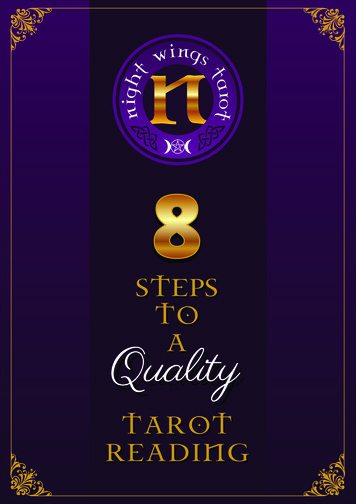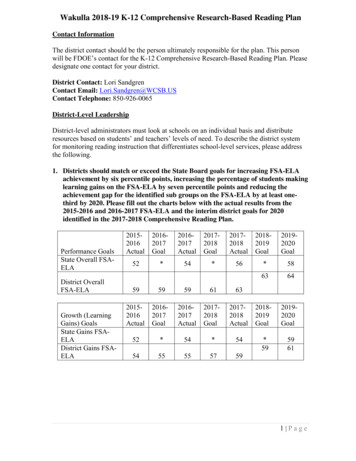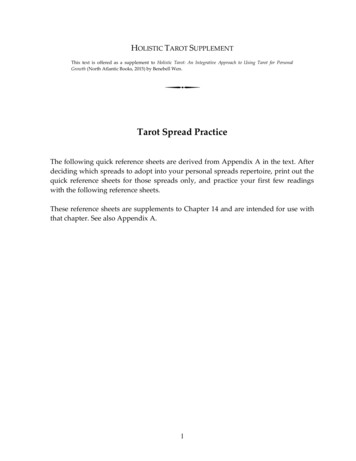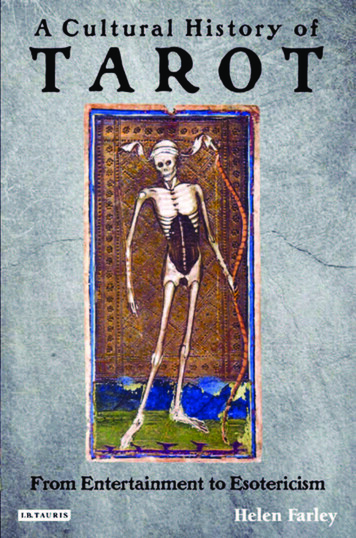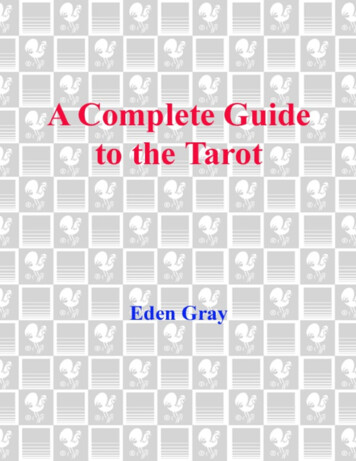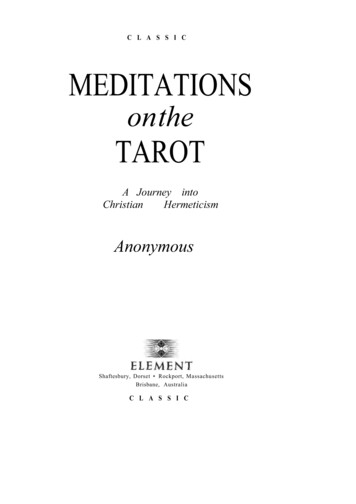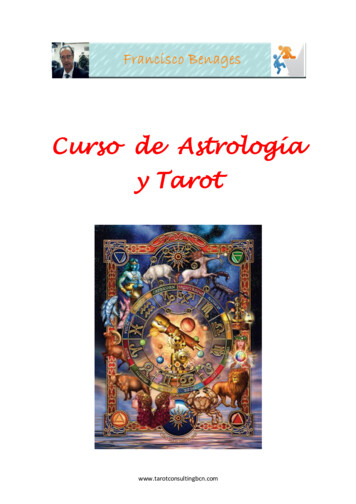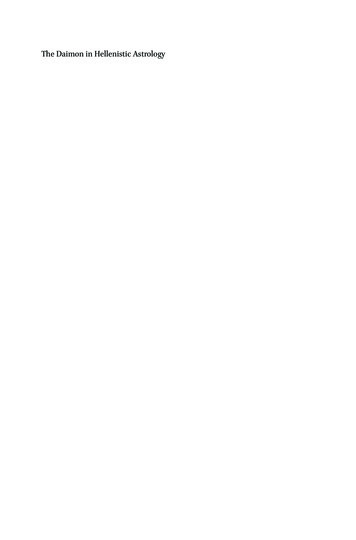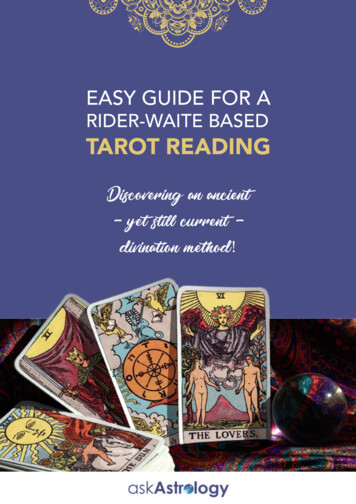
Transcription
EASY GUIDE FOR ARIDER-WAITE BASEDTAROT READINGDiscovering an ancient– yet still current –divination method!
EASY GUIDE FOR ARIDER-WAITE BASEDTAROT READINGDiscovering an ancient– yet still current –divination method!Written by Paul de Senquisse
SUMMARYINTRODUCTION.2CHAPTER IRECOMMENDED TAROT SPREADS.5CHAPTER IITHE MEANING OF THE MAJOR ARCANA.80 – The Fool.8I – The Magician.10Ii – The High Priestess.12Iii – The Empress.14Iv – The Emperor.15V – The Hierophant.16Vi – The Lovers .18Vii – The Chariot.20Viii – Strength .22Ix – The Hermit.24X – The Wheel Of Fortune.26Xi – Justice .28Xii – The Hanged Man.29Xiii – Death.31Xiv – Temperance.33Xv – The Devil.35Xvi – The Tower.37Xvii – The Star.39Xviii – The Moon.41Xix – The Sun.43Xx – Judgment .45Xxi – The World .46
INTRODUCTIONThe Rider-Waite tarot deck, also known as the Rider-Waite-Smith tarot, is byfar the most popular and well-known tarot deck in the world (other famousdecks include Aleister Crowley’s Thoth Tarot, the Deviant Moon tarot deck, andthe French Marseille tarot deck). It is usually the first Tarot deck encountered bypeople living in English-speaking countries.There are a few differences between the meaning and the illustrations of someof the cards when you compare the Rider-Waite-Smith arcana with those foundin earlier decks like the Marseille, but the vast majority of currently producedand designed tarot decks have followed the RWS structure since it was firstpublished in the early 20th century.This tarot is also known as the Rider tarot, the Waite tarot, the Waite-ColemanSmith tarot, the Waite-Smith tarot, and other variations.As a matter of fact, we will use the Rider-Waite-Smith name (or RWS) throughoutyour initiation; Rider was the publisher, Alexander Edward Waite was the author,and Pamela Coleman Smith was the illustrator.Pamela Coleman Smith’s gorgeous illustrations for this tarot deck (as a workfor hire funded by the tarot creator, A.E. Waite) indeed deserve some homageand praise.While the Rider-Waite-Smith deck was first published in 1910, some academics arguethat the history of tarot reading can be traced back to the dawn of time, either to theSumerians, or Ancient Egypt (see various studies about the Thoth tarot deck).Using tarot decks for divinatory purposes began a long, long tome ago. According totradition, the Tarot was already in used during the time of the Pharaohs. According toEgyptian myths, it was a gift to humans from the god Thoth through 22 engravings.Moses, who followed the teachings of the Egyptian high priests, supposedly shared thatknowledge with his people during his flight from Egypt as an alphabet of 22 letters.2
These letters are the basis of Jewish Kabbalah, esoteric teachings that are meant,through study, to spiritually connect humankind with the Divine.The word Tarot appeared in the late 16th century, from the Italian “tarocchi”. This Italian word might be derived from the Arabic “tariqa”, meaning a path of mystical or esoteric knowledge. This term was in turn inspired by the name of the female bodhisattva(or goddess) associated with knowledge and learning in Tibetan Buddhism: Tara!Historically, the first Tarot decks appeared in their current structure over the course ofthe 15th century during the Renaissance in northern Italy.The tarot is an allegorical representation of the secrets of the visible and invisibleworlds, a support for learning based on symbols that take into account the spiritualand psychological dimensions of the universe and of humankind.A history of the Rider-Waite-Smith tarot deckThe Rider-Waite-Smith tarot deck follows the usual 78-card structure of the tarot, divided into 22 major arcana (another name for the cards) and 56 minor arcana.What is notable about the illustrations on the cards of the Rider-Waite-Smith deck isthat contrary to most of the earlier decks like the Marseille, every single card (majorand minor arcana) is illustrated, instead of just the 22 major arcana.This tarot was first published in November 1909 in London, published by the publisherWilliam Rider & Son. It was designed by Arthur Edward Waite (1857-1942), an American-born occultist who lived most of his life in England.A.E. Waite was a grandmaster in a secret society called the Hermetic Order of theGolden Dawn, dedicated to magic, mysticism, and esoteric knowledge.In 1910, A.E. Waite published a guide called “the Key to the Tarot”, provided with adeck of cards, and explaining its history by talking about the traditions it was drawnfrom, providing the required explanations to interpret its arcana.In 1911 the final revised version of the Rider-Waite-Smith tarot deck was published with“The Pictorial Key to the Tarot” that included black and white versions of the 78 cards.The explanations you will find in this book are largely drawn from that one.There were several versions published through the years, including one published in2009 by US Games System Inc to commemorate the hundredth anniversary of this tarot’s initial publication.In that version of the deck called “Smith-Waite Centennial Tarot Deck”, the cardswere published using the original colors that the illustrator Pamela Coleman Smithoriginally chose.3
How to use this simplified version?The method detailed here will only focus on the interpretation of the 22 major arcanaof this tarot deck, even if it is normally based on the use of the entire range of the 78arcana for this deck.The major arcana usually represent particularly striking elements or events that willhave a powerful impact on your life, where minor arcana provide finer details and provide greater clarity to a generic reading.There are four suits in the Rider-Waite-Smith tarot deck, and they are all connected toone of the natural elements The suit of Swords is connected to Air The suit of Pentacles is connected to Earth The suit of Cups is connected to Water The suit of Wands is connected to FireEach suit follows the same 14 card pattern, with numbers from 1 to 10 and four courtcards: the Page, Knight, Queen, and King.The method unveiled in this book will already provide you with a lot of information toguide you with your choices in every domain.Once you are familiar with this short version, you will then have more than enough timedo grow comfortable with using the full Rider-Waite-Smith deck, including the minorarcana.The author of the Rider-Waite-Smith deck, occultist A.E. Waite, wanted a clear breakfrom earlier, Christian-heavy themed arcana like the Marseille deck, and replaced themwith more universal or pagan illustrations.This is why the Pope became a Hierophant, and the Popess became the High Priestess.Likewise, the House of God was replaced with the Tower.The symbolism in the deck draws heavily from the teachings of Eliphas Levi, a famousoccultist from the 19th century.There were also slight alterations to the numbering of the arcana, differing from theMarseille. Justice is the eighth arcanum in the Marseille deck but the eleventh one inthe Rider-Waite-Smith. Conversely, Strength is number 11 in the Marseille and 8 in theRider-Waite-Smith.4
CHAPTER IRECOMMENDED TAROT SPREADSThere are many ways to use the Rider-Waite-Smith tarot deck in a reading. Here are thethree easiest ones for your initiation to this divination tool.Again, while using reversed card is a common feature among Rider-Waite-Smith users,as a beginner it is recommended to shuffle the cards and only focus on the uprightmeanings of the arcana for your early interpretations.1- Single card spreadThis kind of reading is useful whenever you need an answer for something specific.Ask your question, shuffle the cards, and then You can either draw a single card from the facedown deck in your hand, Or you can spread the cards facedown in front of you on a table, then pick one. Interpret the card you have drawn according to your question.2- Past, Present, and Future spreadThis is a useful drawing whenever you need a solution to a problem, or need to knowPastPresentFuturehow to achieve something that you want5
As your question, shuffle the deck, and then Spread the cards facedown before you on a table, then draw three, Put the first one on your left. It represents the past. Put the second one in the middle, it will represent the present. Put the third one on your right, it will represent the future. Interpret the cards you have drawn according to your question. The past card will indicate the mistakes that have been made so far, which prevented your finding a solution to the problem or the achievement of your desire. The present card will indicate what you need to do in order to solve yourproblem or satisfy your desire. The future card will indicate what will happen once the problem has beensolved, or once you have achieved what you wanted.3- The Cross SpreadCard drawn #3Card drawn #2Card drawn #1Card drawn #46
Once you have shuffled the deck, cut it with your left hand and draw a random cardafter asking yourself “Should I perform a reading now?”Flip the card you have drawn. If you have a good first impression, proceed with thereading.If not, consider doing it later.If you had a positive answer, put your hand back in the deck, hold it in your right hand,and mentally come up with a number between 1 and 22.Count the cards in the deck until you reach the number you have selected (in the orderthey have been shuffled in, don’t try to look for the arcanum with that number on thecard)Keep it facedown and place it on your left. It represents the consultant or Querent,which means you if you are performing a reading on your own.Proceed in the same way with a second card, which you will put on the right of the firstone. It represents your current environment.Do it again with a third card, which you will place on top, above the middle of the horizontal line connecting the first two cards. It symbolizes the path that must be taken, orthe evolution of your current situation.Finally, draw a fourth card and place it below the horizontal line between the first twoarcana. It indicates the resolution of this situation.The four cards should now be displayed in a cross shape (see figure above). Now flipthe cards over You can then start your interpretation according to the meaning of these arcana.7
CHAPTER IIThe Meaning of theMajor Arcana0 - TheFoolThe Fool arcanum represents a young enthusiastic manwearing luxury clothes, standing close to the edge of acliff, with a dog that can represent our animal nature.He does not seem bound to the limits of our terrestrialworld, and his eyes are looking up to the divine and celestial planes, showing his aspiration to rise up spiritually even when you sometimesneed to jump into the unknown.He is ready for it, because he is supported by his conviction that Divine Providence willhelp him to improve his human condition.Clearly numbered 0 in the RWS, this arcanum sometimes has no printed number at all,leading to several divergent interpretations (some tarot scholars put it in a differentplace in the succession of arcana).The sun that shines behind him is meant to illuminate the path that should be taken,and protect him as he works towards his goals.Anyway, the Fool represents the arrival of the irrational in the life of the person whodraws this card. In the many common interpretation, the Fool represents wandering,folly, spontaneity, and delirium In some drawings, connected to more negative cards, it can also represent incoherence, madness, doubts, and instincts or emotions that are out of control.In that case, the Fool acts as an amplifier and negative card in every aspect: Love,Work, Health, Money, Luck It is then a sign of confusion and indecision that will affect ongoing or upcoming projects. Likewise, the Querent might be full of new ideas that might make it harder tomake
The tarot is an allegorical representation of the secrets of the visible and invisible worlds, a support for learning based on symbols that take into account the spiritual and psychological dimensions of the universe and of humankind. A history of the Rider-Waite-Smith tarot deck The Rider-Waite-Smith tarot deck follows the usual 78-card structure of the tarot, divid-ed into 22 major arcana .
